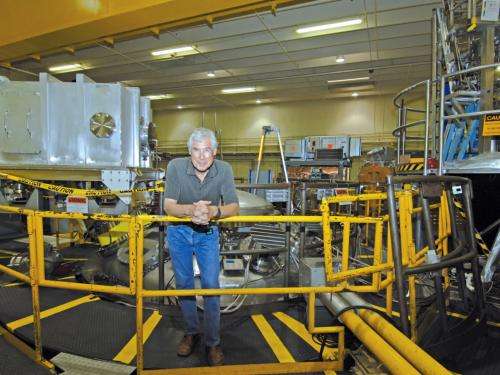High-impact Sandia physicist publishes technical, yet personal, memoir

The swan song of retiring Sandia physicist Tom Sanford is in a technical, yet personal, memoir about experiments that changed the course of research at particle accelerators around the world.
His experiments in the mid-1990s made the Z accelerator a more effective candidate to achieve peacetime fusion energy—a goal pursued by Z researchers today. Z also tests materials by subjecting them to the almost unimaginable conditions present in stars and nuclear weapons.
Sanford went on to share the 2005 Hannes Alfven Prize of the European Physical Society "for the remarkable achievements of the multi-filament Z-pinch development of recent years."
The breakthrough generally credited to him is finding that a Z-pinch—the "pinching" magnetic field formed around a vertical electrical current—could be stabilized when huge currents were passed through an orderly forest of tiny wires. The innovation created a huge, briefly stable magnetic field that smashed together metal particles from the ionized wires to release X-rays and in the space of a year tripled the output of a smaller Sandia accelerator called Saturn. It was successfully applied to Z, which then became the world's largest producer of laboratory X-rays.
Among other uses, the strengthened X-rays were used to crush deuterium capsules, releasing the neutrons that demonstrate a fusion reaction.
Sanford's memoir relates other work as well.
At Sandia's HERMES III accelerator, his earlier effort to create the required radiation field gave him migraine headaches when the generated beam—theoretically perfect—kept pinching, an unwanted reaction.
"Subsequently," he wrote, "I found out that the crate containing the large heavy graphite target being used had been left out in the rain before being installed. The crate had leaked and the graphite likely contained moisture. This could easily explain why the beam pinched. The incident beam would have heated any moisture, creating ions."
A nice deduction, but unfortunately, heating the graphite to drive out moisture failed to solve the problem. The HERMES team tried replacing the surface of the target with a new foil and other modifications, to no effect. Finally, a technician found electrical burn marks on an obscure tantalum shield that had not been secured. "The shield was removed and the beam immediately snapped into the calculated position and my migraine disappeared," Sanford wrote.
Not reluctant to demonstrate that even successful people sometimes fail, he wrote that he once had to buy pulsed-power director Keith Matzen a double-decker ice cream cone when Sanford lost a bet on the amount of output that would result from increasing the mass of Z's wire target.
"My history of moving without restrictions from project to project," he noted, "illustrates how Sandia provides opportunities for scientific challenge."
Sanford found challenge in a variety of pulsed power reactions for 30 years at Sandia before recently retiring. His memoir, "History of HERMES III Diode to Z-pinch Breakthrough and Beyond," was published as a Sandia report in April 2013.
Provided by Sandia National Laboratories




















